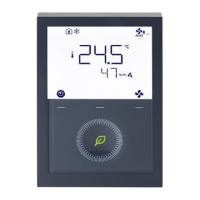RDG264KN and previous RDG260KN software versions use parameter P256 to
adjust max flow limitation on the PICV for heating. Limiting the water flow for
cooling is not available.
The function can be enabled on all combined heating/cooling applications with
DC 0...10 V output for universal and fan coil unit applications.
For applications with 6-port PICV, the maximal water flow limitation can be set
directly in liters per hours (l/h) via smartphone APP, based on the installed
diameter nominal (DN) of the valve.
The function can be enabled for all heating/cooling applications with DC 0...10 V
output. RDG264KN only: P256, max flow for heating is visible only for PICV
applications.
X1
Dewpoint monitoring is essential to prevent condensation on the chilled ceiling
(cooling with fan disabled, P350 = 0) and associated damages to the building.
A dewpoint sensor with a potential-free contact is connected to multifunctional
input X1, X2 or U1 (RDG2..KN)/X3 (RDG2..T). If there is condensation, the cooling
valve is fully closed until no more condensation is detected, and the cooling output
is disabled temporarily.
If the fan function is enabled (P350 ≠ 0), the fan continues to work as long as the
dewpoint function is active.
When condensation is detected with
● Control only with 6-port control ball valve:
– If P201 = 6 or 8, the valve closes (5 V).
– If P201 = 7 or 9, the valve closes (6 V).
● Control with combi-valve (PICV): The PICV closes and the 6-port ball valve
remains open.
The condensation symbol is displayed during temporary override and fault
"Condensation in room" is sent via bus.
The input must be commissioned accordingly (P150, P153 and P155).
See Multifunctional input, digital input [➙ 115].
To prevent valve freezing after extended inactivity (e.g. cooling valves in winter),
valves need to be activated periodically. To save energy, the valve kick/exercising
function is triggered when valves are closed for 91 hours. The valves are then
activated for 2 minutes. This function can be enabled via P250.

